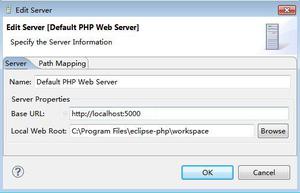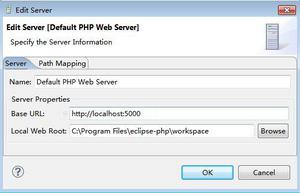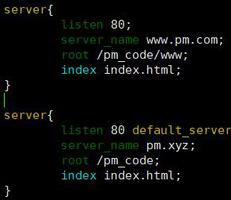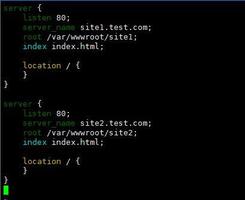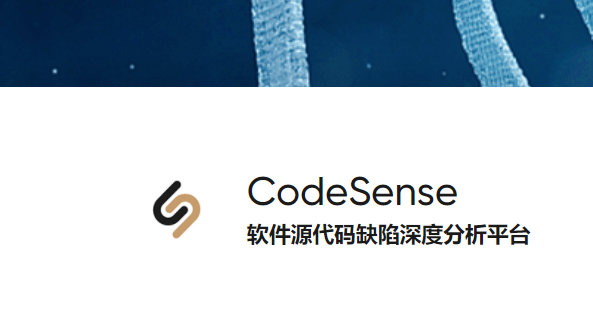MyBatis insert实体如何返回主键
insert实体如何返回主键
一、insert 属性详解
parameterType:入参的全限定类名或类型别名keyColumn:设置数据表自动生成的主键名。对特定数据库(如PostgreSQL),若自动生成的主键不是第一个字段则必须设置keyProperty:默认值unset,用于设置getGeneratedKeys方法或selectKey子元素返回值将赋值到领域模型的哪个属性中useGeneratedKeys:取值范围true|false(默认值),设置是否使用JDBC的getGenereatedKeys方法获取主键并赋值到keyProperty设置的领域模型属性中。MySQL和SQLServer执行auto-generated key field,因此当数据库设置好自增长主键后,可通过JDBC的getGeneratedKeys方法获取。但像Oralce等不支持auto-generated key field的数据库就不能用这种方法获取主键了statementType:取值范围STATEMENT,PREPARED(默认值),CALLABLEflushCache:取值范围true(默认值)|false,设置执行该操作后是否会清空二级缓存和本地缓存timeout:默认为unset(依赖jdbc驱动器的设置),设置执行该操作的最大时限,超时将抛异常databaseId:取值范围oracle|mysql等,表示数据库厂家,元素内部可通过`<if test="_databaseId = 'oracle'">`来为特定数据库指定不同的sql语句
二、Mapper接口
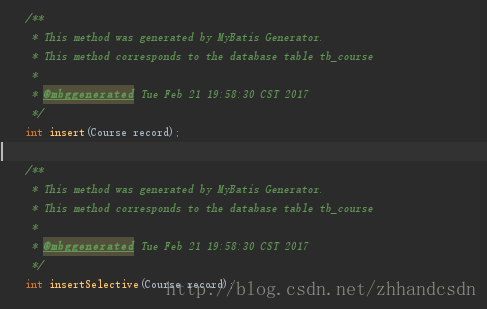
三、执行mapper.xml 返回主键
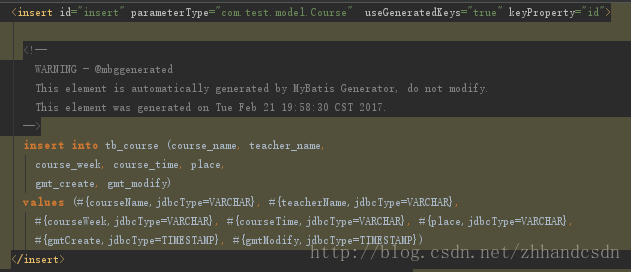

两种方式均满足需求。
注意:mapper接口返回值依然是成功插入的记录数,但不同的是主键值已经赋值到领域模型实体的id中了。
四、测试结果
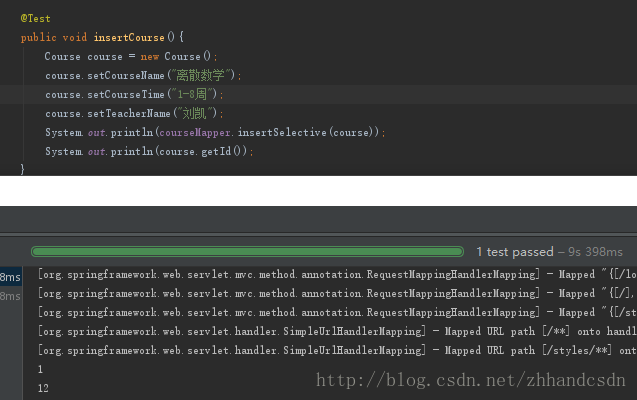
六、批量插入
<insert id="add" parameterType="com.test.model.Course">
<foreach collection="list" item="item" index="index" separator=";">
insert into tb_course (course_name, teacher_name,
course_week, course_time, place,
gmt_create, gmt_modify)
values (#{courseName,jdbcType=VARCHAR}, #{teacherName,jdbcType=VARCHAR},
#{courseWeek,jdbcType=VARCHAR}, #{courseTime,jdbcType=VARCHAR}, #{place,jdbcType=VARCHAR},
#{gmtCreate,jdbcType=TIMESTAMP}, #{gmtModify,jdbcType=TIMESTAMP})
</foreach></insert>
七、小结一下
两种方式:
1、添加属性 useGeneratedKeys="true" keyProperty="id"
2、添加代码
<selectKey resultType="java.lang.Short" order="AFTER" keyProperty="id">
SELECT LAST_INSERT_ID() AS id
</selectKey>
推荐使用第一种!
Mybatis添加记录,返回主键id
Role.java实体类
public class Role implements Serializable {
private String roleId;
private String name;
private Integer status;
public String getRoleId() {
return roleId;
}
public void setRoleId(String roleId) {
this.roleId = roleId;
}
public String getName() {
return name;
}
public void setName(String name) {
this.name = name;
}
public Integer getStatus() {
return status;
}
public void setStatus(Integer status) {
this.status = status;
}
}
SysRoleDao.java
public interface SysRoleDao {
public int addRole(SysRole role);
}
mapper-role.xml
<insert id="addRole" parameterType="SysRole" useGeneratedKeys="true" keyProperty="roleId" keyColumn="role_id">
insert into t_sys_role(
name,status
)
values(
#{name,jdbcType=VARCHAR},
#{status,jdbcType=VARCHAR},
)
</insert>
注:
1、添加记录能够返回主键的关键点在于需要在<insert>标签中添加以下三个属性<insert useGeneratedKeys="true" keyProperty="id" keyColumn="id"></insert>。
useGeneratedKeys:必须设置为true,否则无法获取到主键id。keyProperty:设置为POJO对象的主键id属性名称。keyColumn:设置为数据库记录的主键id字段名称
2、新添加主键id并不是在执行添加操作时直接返回的,而是在执行添加操作之后将新添加记录的主键id字段设置为POJO对象的主键id属性
TestDao.java
@RunWith(SpringJUnit4ClassRunner.class)
@ContextConfiguration(locations= {"classpath:config/spring-core.xml","classpath:config/spring-web.xml"})
public class TestDao{
@Autowired
SysRoleDao roleDao;
@Test
public void test() {
SysRole role=new SysRole();
role.setName("admin10");
role.setStatus(1);
System.out.println("返回结果:"+roleDao.addRole(role));
System.out.println("主键id:"+role.getRoleId());
}
}
打印结果
返回结果:1
主键id:12
以上为个人经验,希望能给大家一个参考,也希望大家多多支持。
以上是 MyBatis insert实体如何返回主键 的全部内容, 来源链接: utcz.com/p/251266.html



